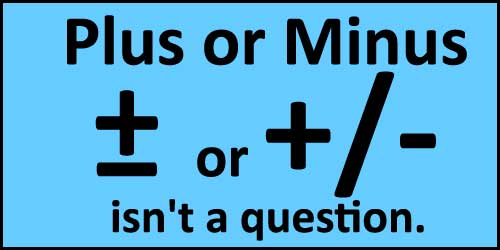Plus or Minus Isn’t a Question – Watts Up With That?

Guest Essay by Kip Hansen —10 December 2022
“In mathematics, the ± sign [or more easily, +/-] is used when we have to show the two possibilities of the desired value, one that can be obtained by addition and the other by subtraction. [It] means there are two possible answers of the initial value. In science it is significantly used to show the standard deviation, experimental errors and measurement errors.” [ source ] While this is a good explanation, it is not entirely correct. It isn’t that there are two possible answers, it is that the answer could be as much as or as little as the “two possible values of the initial value” – between the one with the absolute uncertainty added and the one with the absolute uncertainty subtracted.
[ Long Essay Warning: This is 3300 words – you might save it for when you have time to read it in its entirety – with a comforting beverage in your favorite chair in front of the fireplace or heater.]
When it appears as “2.5 +/- 0.5 cm”, it is used to indicate that the central value “2.5” is not necessarily the actually the value, but rather that the value (the true or correct value) lies between the values “2.5 + 0.5” and “2.5 – 0.5”, or fully stated calculated “The value lies between 3 cm and 2 cm”. This is often noted to be true to a certain percentage of probability, such as 90% or 95% (90% or 95% confidence intervals). The rub is that the actual accurate precise value is not known, it is uncertain; we can only correctly state that the value lies somewhere in that range — but only “most of the time”. If the answer is to 95% probability, then 1 out of 20 times, the value might not lie within the range of the upper and lower limits of the range, and if 90% certainty, then 1 out of ten times the true value may well lie outside the range.
This is important. When dealing with measurements in the physical world, the moment the word “uncertainty” is used, and especially in science, a vast topic has been condensed into a single word. And, a lot of confusion.
Many of the metrics presented in many scientific fields are offered as averages, as the arithmetic or probabilistic averages (usually ‘means’). And thus, when any indication of uncertainty or error is included, it is many times not the uncertainty of the mean value of the metric, but the uncertainty of the mean of the values. This oddity alone is responsible for a lot of the confusion in science.
That sounds funny, doesn’t it. But there is a difference that becomes important. The mean value of a set of measurements is given in the formula:
So, the average—the arithmetic mean—by that formula itself carries with it the uncertainty of the original measurements (observations). If the original observations look like this: 2 cm +/- 0.5 cm then the value of the mean will have the same form: 1.7 cm +/- the uncertainty. We’ll see how this is properly calculated below.
In modern science, there has developed a tendency to substitute instead of that, the “uncertainty of the mean” – with a differing definition that is something like “how certain are we that that value IS the mean?”. Again, more on this later.
Example: Measurements of high school football fields, made rather roughly to the nearest foot or two (0.3 to 0.6 meters), say by counting the yardline tick marks on the field’s edge, give a real measurement uncertainty of +/- 24 inches. By some, this could be averaged to produce a mean of measurements of many high school football fields by a similar process with the uncertainty of the mean reportedly reduced to a few inches. This may seem trivial but it is not. And it is not rare, but more often the standard. The pretense that the measurement uncertainty (sometimes stated as original measurement error) can be reduced by an entire order of magnitude by stating it as the “uncertainty of the mean” is a poor excuse for science. If one needs to know how certain we are about the sizes of those football fields, then we need to know the real original measurement uncertainty.
The trick here is switching from stating the mean with its actual original measurement uncertainty (original measurement error) replacing it with the uncertainty of the mean. The new much smaller uncertainty of the mean is a result of one of two things: 1) it is the Product of Division or 2) Probability (Central Limit Theory).
Case #1, the football field example is an instance of: a product of division. In this case, the uncertainty is no longer about the length of the, and any of the, football fields. It is only how certain we are of the arithmetic mean, which is usually only a function of how many football fields were included in the calculation. The original measurement uncertainty has been divided by the number of fields measured in a mockery of the Central Limit Theory.
Case#2: Probability and Central Limit Theorem. I’ll have to leave that topic for the another part in this series – so, have patience and stay tuned.
Now, if arithmetical means are all you are concerned about – maybe you are not doing anything practical or just want to know, in general, how long and wide high school football fields are because you aren’t going to actually order astro-turf to cover the field at the local high school, you just want a ball-park figure (sorry…). So, in that case, you can go with the mean of field sizes which is about 57,600 sq.ft (about 5351 sq. meters), unconcerned with the original measurement uncertainty. And then onto the mean of the cost of Astro-turfing a field. But, since “Installation of an artificial turf football field costs between $750,000 to $1,350,000” [ source ], it is obvious that you’d better get out there with surveying-quality measurement tools and measure your desired field’s exact dimensions, including all the area around the playing field itself you need to cover. As you can see, the cost estimates have a range of over half a million dollars.
We’d write that cost estimate as a mean with an absolute uncertainty — $1,050,000 (+/- $300,000). How much your real cost would be would depends on a lot of factors. At the moment, with no further information and details, that’s what we have….the best estimate of cost is in there somewhere —> between $750,000 and $1,350,000 – but we don’t know where. The mean $1,050,000 is not “more accurate” or “less uncertain”. The correct answer, with available data, is the RANGE.
Visually, this idea is easily illustrated with regards to GISTEMPv4:
The absolute uncertainty in GISTEMPv4 was supplied by Gavin Schmidt. The black trace, which is a mean value, is not the real value. The real value for the year 1880 is a range—about 287.25° +/- 0.5°. Spelled out properly, the GISTEMP in 1880 was somewhere between 286.75°C and 287.75°C. That’s all we can say. GISTEMPv4 mean for 1980, one hundred years later, still fits inside that range with the uncertainty ranges of both years overlapping by about 0.3°C; meaning it is possible that the mean temperature had not risen at all. In fact, uncertainty ranges for Global Temperature overlap until about 2014/2015.
The quote from Gavin Schmidt on this exact point:
“But think about what happens when we try and estimate the absolute global mean temperature for, say, 2016. The climatology for 1981-2010 is 287.4±0.5K, and the anomaly for 2016 is (from GISTEMP w.r.t. that baseline) 0.56±0.05ºC. So our estimate for the absolute value is (using the first rule shown above) is 287.96±0.502K, and then using the second, that reduces to 288.0±0.5K. The same approach for 2015 gives 287.8±0.5K, and for 2014 it is 287.7±0.5K. All of which appear to be the same within the uncertainty. Thus we lose the ability to judge which year was the warmest if we only look at the absolute numbers.” [ source – repeating the link ]
To be absolutely correct, the global annual mean temperatures have far more uncertainty than is shown or admitted by Gavin Schmidt, but at least he included the known original measurement error (uncertainty) of the thermometer-based temperature record. Why is that? Why is it greater than that? …. because the uncertainty of a value is the cumulative uncertainties of the factors that have gone into calculating it, as we will see below (and +/- 0.5°C is only one of them).
Averaging Values that have Absolute Uncertainties
Absolute uncertainty. The uncertainty in a measured quantity is due to inherent variations in the measurement process itself. The uncertainty in a result is due to the combined and accumulated effects of these measurement uncertainties which were used in the calculation of that result. When these uncertainties are expressed in the same units as the quantity itself they are called absolute uncertainties. Uncertainty values are usually attached to the quoted value of an experimental measurement or result, one common format being: (quantity) ± (absolute uncertainty in that quantity). [ source ]
Per the formula for calculating a arithmetic mean above, first we add all the observations (measurements) and then we divide the total by the number of observations.
How do we then ADD two or more uncertain values, each with its own absolute uncertainty?
The rule is:
When you add or subtract the two (or more) values to get a final value, the absolute uncertainty [given as “+/- a numerical value”] attached to the final value is the sum of the uncertainties. [ many sources: here or here]
For example:
5.0 ± 0.1 mm + 2.0 ± 0.1 mm = 7.0 ± 0.2 mm
5.0 ± 0.1 mm – 2.0 ± 0.1 mm = 3.0 ± 0.2 mm
You see, it doesn’t matter if you add or subtract them, the absolute uncertainties are added. This applies no matter how many items are being added or subtracted. In the above example, if 100 items (say sea level rise at various locations) each with its own absolute measurement uncertainty of 0.1 mm, then the final value would have an uncertainty of +/- 10 mm (or 1 cm).
This is principle easily illustrated in a graphic:
In words: ten plus or minus one PLUS twelve plus or minus one EQUALS twenty-two plus or minus two. Ten plus or minus 1 really signifies the range eleven down to nine and twelve plus or minus one signifies the range thirteen down to eleven. Adding the two higher values of the ranges, eleven and thirteen, gives twenty-four which is twenty-two (the sum of ten and twelve on the left) plus two, and adding the too lower values of the ranges, nine and eleven, gives the sum of twenty which is twenty-two minus two. Thus our correct sum is twenty-two plus or minus two, shown at the top right.
Somewhat counter-intuitively, the same is true if one subtracts one uncertain number from another, the uncertainties (the +/-es) are added, not subtracted, giving a result (the difference) more uncertain than either the minuend (the top number) or the subtrahend (the number being subtracted from the top number). If you are not convinced, sketch out your own diagram as above for a subtraction example.
What are the implications of this simple mathematical fact?
When one adds (or subtracts) two values with uncertainty, one adds (or subtracts) the main values and adds the two uncertainties (the +/-es) in either case (addition or subtraction) – the uncertainty of the total (or difference) is always higher than the uncertainty of either original values.
How about if we multiply? And what if we divide?
If you multiply one value with absolute uncertainty by a constant (a number with no uncertainty)
The absolute uncertainty is also multiplied by the same constant.
eg. 2 x (5.0 ± 0.1 mm ) = 10.0 ± 0.2 mm
Likewise, if you wish to divide a value that has an absolute uncertainty by a constant (a number with no uncertainty), the absolute uncertainty is divided by the same amount. [ source ]
So, 10.0 mm +/- 0.2mm divided by 2 = 5.0 +/- 0.1 mm.
Thus we see that the arithmetical mean of the two added measurements (here we multiplied but it is the same as adding two–or two hundred–measurements of 5.0 +/- 0.1 mm) is the same as the uncertainty in the original values, because, in this case, the uncertainty of all (both) of the measurement is the same (+/- 0.1). We need this to evaluate averaging – the finding of a arithmetical mean.
So, now let’s see what happens when we find a mean value of some metric. I’ll use a tide gauge record as tide gauge measurements are given in meters – they are addable (extensive property) quantities. As of October 2022, the Mean Sea Level at The Battery was 0.182 meters (182 mm, relative to the most recent Mean Sea Level datum established by NOAA CO-OPS.) Notice that here is no uncertainty attached to the value. Yet, even mean sea levels relative to the Sea Level datum must be uncertain to some degree. Tide gauge individual measurements have a specified uncertainty of +/- 2 cm (20 mm). (Yes, really. Feel free to read the specifications at the link).
And yet the same specifications claim an uncertainty of only +/- 0.005 m (5 mm) for monthly means. How can this be? We just showed that adding all of the individual measurements for the month would add all the uncertainties (all the 2 cms) and then the total AND the combined uncertainty would both be divided by the number of measurements – leaving again the same 2 cm as the uncertainty attached to the mean value.
The uncertainty of the mean would not and could not be mathematically less than the uncertainty of the measurements of which it is comprised.
How have they managed to reduce the uncertainty to 25% of its real value? The clue is in the definition: they correctly label it the “uncertainty of the mean” — as in “how certain are we about the value of the arithmetical mean?” Here’s how they calculate it: [same source]
| “181 one-second water level samples centered on each tenth of an hour are averaged, a three standard deviation outlier rejection test applied, the mean and standard deviation are recalculated and reported along with the number of outliers. (3 minute water level average)” |
Now you see, they have ‘moved the goalposts’ and are now giving not the uncertainty of the value of mean at all, but the “standard deviation of the mean” where “Standard deviation is a measure of spread of numbers in a set of data from its mean value.” [ source or here ]. It is not the uncertainty of the mean. In the formula given for arithmetic mean (image a bit above), the mean is determined by a simple addition and division process. The numerical result of the formula for the absolute value (the numerical part not including the +/-) is certain—addition and division produce absolute numeric values — there is no uncertainty about that value. Neither is there any uncertainty about the numeric value of the summed uncertainties divided by the number of observations.
Let me be clear here: When one finds the mean of measurements with known absolute uncertainties, there is no uncertainty about the mean value or its absolute uncertainty. It is a simple arithmetic process.
The mean is certain. The value of the absolute uncertainty is certain. We get a result such as:
3 mm +/- 0.5 mm
Which tells us that the numeric value of the mean is a range from 3 mm plus 0.5 mm to 3 mm minus 0.5 mm or the 1 mm range: 3.5 mm to 2.5 mm.
The range cannot be further reduced to a single value with less uncertainty.
And it really is no more complex than that.
# # # # #
Author’s Comment:
I heard some sputtering and protest…But…but…but…what about the (absolutely universally applicable) Central Limit Theorem? Yes, what about it? Have you been taught that it can be applied every time one is seeking a mean and its uncertainty? Do you think that is true?
In simple pragmatic terms, I have showed above the rules for determining the mean of a value with absolute uncertainty — and shown that the correct method produces certain (not uncertain) values for both the overall value and its absolute uncertainty. And that these results represent a range.
Further along in this series, I will discuss why and under what circumstances the Central Limit Theorem shouldn’t be used at all.
Next, in Part 2, we’ll look at the cascading uncertainties of uncertainties expressed as probabilities, such as “40% chance of”.
Remember to say “to whom you are speaking”, starting your comment with their commenting handle, when addressing another commenter (or, myself). Use something like “OldDude – I think you are right….”.
Thanks for reading.
# # # # #




